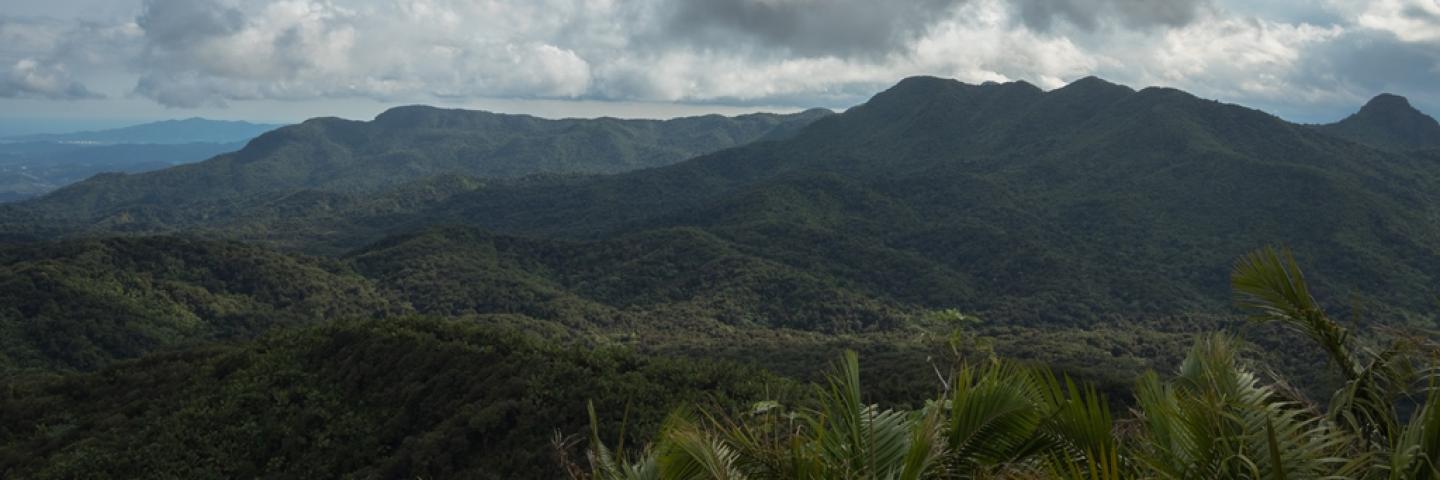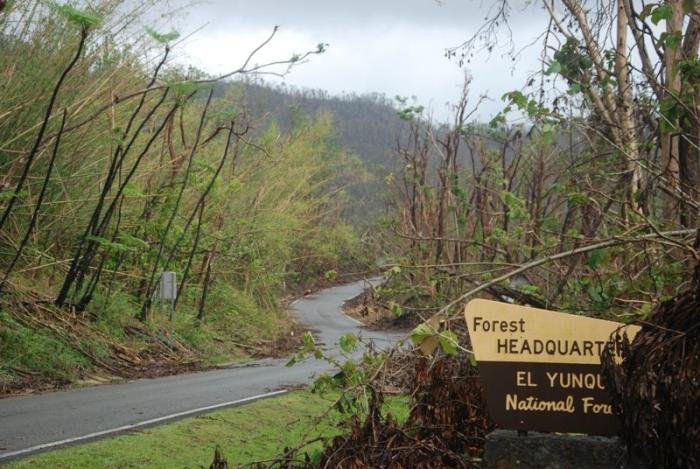
Announced January 14, 2021, NRCS, Forest Service and conservation partners are collaborating at a landscape scale to increase conservation actions on private lands to improve ecosystem function and health in 22 counties in eastern Puerto Rico.
(en Español)
Led by the US Forest Service State and Private Forestry programs of the International Institute of Tropical Forestry (IITF), the project aims to increase conservation on private lands to improve ecosystem function and health in 22 municipalities in eastern Puerto Rico while improving economic and ecological services for local communities that were impacted by the 2017 hurricanes. Working in partnership, and at this scale, helps reduce wildfire threats, protect water quality and supply, and improve wildlife habitat for at-risk species.

Background
Eastern Puerto Rico is a biodiversity hotspot - home to 27 endangered species and the largest remnant of primary forest left on the island. The region encompasses five watersheds (NRCS Hydrologic Unit Code 10), supplying public water to over 45% of Puerto Rico’s population, including parts of the San Juan Metropolitan Area. The area consists of a complex matrix of intermixed land covers (60% forested land, 15% developed land, 2% wetland, 1.2% water bodies, 12% pasture/hay, 1.5% agricultural land, and 8.3% other, see Figure 1). Protected areas make up 11% or 49,927 acres (200 km2) of this region, including El Yunque National Forest - the only tropical forest in the U.S. National Forest System - as well as a network of ecologically and culturally important protected areas mostly managed by the Puerto Rico government and Para la Naturaleza (PLN; a unit of the Puerto Rico Conservation Trust). The rich natural and cultural resources in this region are threatened by a combination of anthropogenic activity - deforestation, urban sprawl, land conversion, and recreational overuse - and extreme weather events (extended periods of severe drought, more frequent and intense hurricanes, and intense rain events that increase landslides, erosion, and sedimentation).
Puerto Rico’s eastern region was severely impacted by two major hurricanes (Irma and María) in 2017. The center of Hurricane María directly impacted the region, entering through the southeastern coast and crossing the Island diagonally. Two-thirds of the population was already without electricity and one third without water supply as a result of the passing of Hurricane Irma two weeks earlier; subsequently Hurricane María caused the loss of many human lives and unprecedented catastrophic damage to the Puerto Rico's entire infrastructure, service networks, private property, agricultural lands, ecosystems and wildlife habitats. This widespread catastrophic damage created a need to reassess forest and other natural resource management needs in the region in order to restore the forest that helps protect water resources from sedimentation and erosion.
Only 5,231 acres (3.6 km2) or 1.1% of Puerto Rico's eastern region’s private land area is currently enrolled in USDA Forest Service and NRCS natural resources management and conservation programs. About 649,712 people (US Census 2018) live in the area within 17 municipalities, with about 44.7% living below the poverty level (average per capita income of $11,483). Economic hardship has been exacerbated by the COVID-19 pandemic, which raised unemployment rates in Puerto Rico to an estimated 26.6%. Primary agricultural activities in the region are cattle and livestock, hay, and plantain production on about 1,150 farms (2018 Puerto Rico Census of Agriculture).

Partners
Partners in this project include:
- International Institute of Tropical Forestry (IITF),
- US Fish & Wildlife Service (FWS),
- Para La Naturaleza,
- Protectores de Cuencas,
- Envirosurvey Inc.,
- Centro para la Conservación del Paisaje,
- University of Puerto Rico Sea Grant, and
- the Suroeste Soil and Water Conservation District
Goals & Objectives
The Joint Chief’s Landscape-scale Restoration Partnership aims to promote effective land management to restore, conserve, and protect forest land and other natural resources; define biological corridors between public and private lands; and establish new populations of federally-listed threatened and endangered plant species in eastern Puerto Rico. The project will help increase conservation actions on private lands to improve ecosystem function and health in the region while improving economic and ecological services to local communities. This project will also complement efforts by the Rio Fajardo Watershed Management Plan Implementation Project through the recently approved National Water Quality Initiative project for the Río Fajardo watershed (map at right).
Objective 1: Improve habitat conditions for at-risk species.
- Define passive (natural regeneration, overstory management, etc.) and active (tree planting, nucleation and tree clusters, etc.) forest landscape restoration practices,
- Define habitat and forest restoration considering native species (to promote agroforestry practices and forest enhancement with species that should provide a stronger resiliency to the region,
- Habitat restoration for targeted species, and
- Establish new populations of targeted threatened and endangered plant species.
Objective 2: Protect water quality and supply for communities and industry.
- Erosion control measures,
- Nutrient and waste management,
- Design and establish practices to mitigate disturbances, and
- Debris and obstruction removal.
Resource Concerns
The resource concerns to be addressed in this region are:
- Soil: Sheet and Rill Erosion; Classic Gully Erosion; Bank Erosion from streams, shorelines, or water conveyance channels; and Soil organism habitat loss or degradation.
- Water: Nutrients transported to ground and surface waters; Pesticides transported to ground and surface waters; Sediment transported to surface water; and Elevated water temperature.
- Plants: Plant structure and composition.
- Animals: Terrestrial habitat for wildlife and invertebrates; Aquatic habitat for fish and other organisms.

Actions
Conservation practices will be implemented on at least 30 non-industrial private forest and agricultural properties to promote connectivity between private and public lands. Partners will also conserve and protect targeted species through biological corridor establishment, wildlife habitat improvement, and establishment of new populations of threatened and endangered (T&E) plant species. Furthermore, the rare native tree Eugenia haematocarpa will be propagated and planted at El Yunque National Forest to increase the current populations and improve habitat conditions. This species is currently propagated at El Yunque; continued propagation and establishment of new individuals will ensure the long-term viability of this endangered species within the National Forest. Partners will also develop outreach and restoration techniques and structured management plans with clearly defined goals to integrate wildlife conservation with ecosystem services protection (such as water quantity and soil health).
FY 2021 Accomplishments
- Local partners participated in 12 project meetings throughout the year and began outreach activities within local communities. Partners like Centro para la Conservación del Paisaje have been educating local landowners about best forest management practices.
- Twelve farmers signed conservation contracts with NRCS for a total of $250,824 on over 402 acres. These contracts are providing technical and financial assistance to farmers to implement conservation practices like Tree/Shrub Establishment, Hedgerow Planting, Silvopasture and Riparian Forest Buffer. Over 1,500 trees will be planted through these conservation contracts. Conservation practices empower landowners to protect the water resources in the region by controlling soil erosion and restoring forest lands.
Proyecto para la Resiliencia del Ecosistema a través de prácticas de conservación en Puerto Rico
Visión General
Colaboradores
el Instituto Internacional de Silvicultura Tropical (IITF), el Servicio de Pesca y Vida Silvestre de los Estados Unidos, Para La Naturaleza, Protectores de Cuencas Inc., Envirosurvey Inc., el Centro para la Conservación del Paisaje, Sea Grant y el Distrito de Conservación de Suelos y Aguas del Suroeste.
Metas y objetivos
Preocupaciones de recursos
El Proyecto para la Resiliencia del Ecosistema a través de prácticas de conservación de Puerto Rico es uno de los ocho nuevos proyectos. Los beneficiarios del proyecto trabajarán en colaboración a nivel de paisaje para aumentar la implementación de prácticas de conservación en tierras privadas para mejorar la función de los ecosistemas y la salud en 17 municipios del este de Puerto Rico, al tiempo que mejorarán los servicios económicos y ecológicos para las comunidades locales que se vieron afectados por los huracanes del 2017. Los programas forestales del FS y del Sector privado del Instituto Internacional de Silvicultura Tropical lideraron los esfuerzos de los organismos en la coordinación de este proyecto colaborativo.
Acciones
El proyecto propone implementar prácticas de conservación en 30 propiedades agrícolas y forestales privadas no industriales para promover la conectividad de hábitat entre tierras privadas y públicas. Los beneficiarios también conservarán y protegerán las especies identificadas mediante el establecimiento de corredores biológicos, la mejora del hábitat de vida silvestre y el establecimiento de nuevas poblaciones de especies vegetales amenazadas y en peligro de extinción (T&E). Además, el árbol nativo Eugenia haematocarpa se propagará y plantará en el Bosque Nacional El Yunque para aumentar las poblaciones actuales y mejorar las condiciones del hábitat. Esta especie se propaga actualmente en El Yunque; la propagación continua y el establecimiento de nuevos individuos garantizará la viabilidad a largo plazo de esta especie en peligro de extinción dentro del Bosque Nacional. Los socios también desarrollarán técnicas de divulgación y restauración y planes de manejo estructurados con objetivos claramente definidos para integrar la conservación de la vida silvestre con la protección de los servicios ecosistémicos (como la cantidad de agua y la salud del suelo).
Logros del año fiscal 2021

